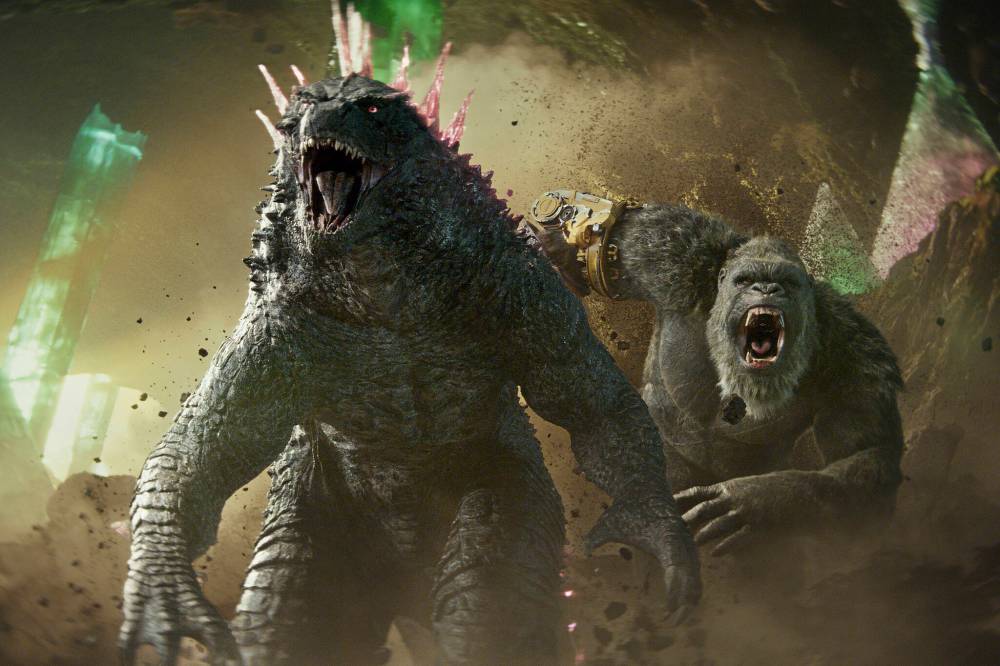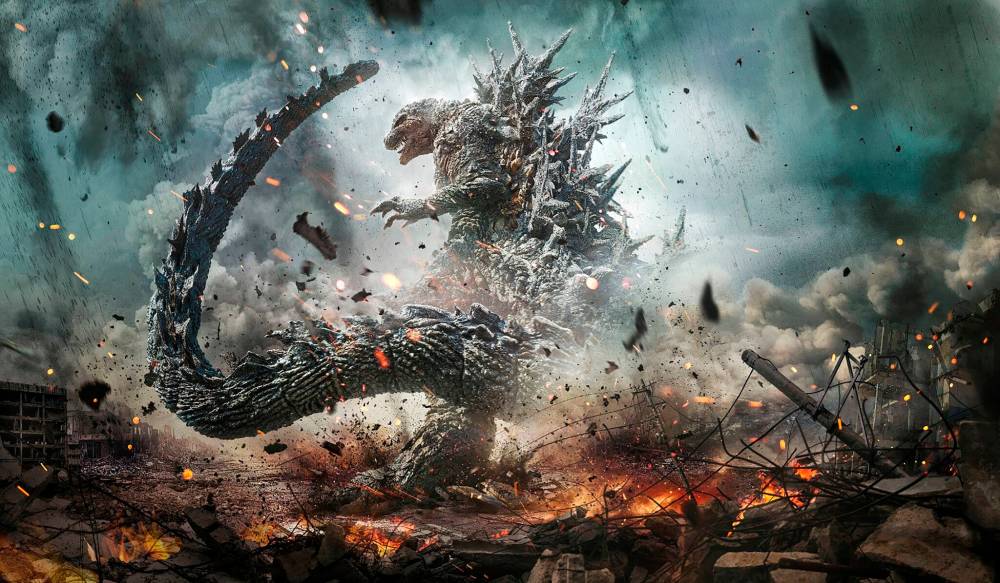A tale of two kaiju
New Godzilla film comes on heels of Toho’s Oscar-winning 2023 effort
Advertisement
Read this article for free:
or
Already have an account? Log in here »
To continue reading, please subscribe:
Monthly Digital Subscription
$1 per week for 24 weeks*
- Enjoy unlimited reading on winnipegfreepress.com
- Read the E-Edition, our digital replica newspaper
- Access News Break, our award-winning app
- Play interactive puzzles
*Billed as $4.00 plus GST every four weeks. After 24 weeks, price increases to the regular rate of $19.00 plus GST every four weeks. Offer available to new and qualified returning subscribers only. Cancel any time.
Monthly Digital Subscription
$4.75/week*
- Enjoy unlimited reading on winnipegfreepress.com
- Read the E-Edition, our digital replica newspaper
- Access News Break, our award-winning app
- Play interactive puzzles
*Billed as $19 plus GST every four weeks. Cancel any time.
To continue reading, please subscribe:
Add Winnipeg Free Press access to your Brandon Sun subscription for only
$1 for the first 4 weeks*
*$1 will be added to your next bill. After your 4 weeks access is complete your rate will increase by $0.00 a X percent off the regular rate.
Read unlimited articles for free today:
or
Already have an account? Log in here »
Hey there, time traveller!
This article was published 30/03/2024 (553 days ago), so information in it may no longer be current.
This November will mark 70 years since Godzilla first rose from the sea to terrorize Tokyo and he’s as much of a contender as ever.
Movie buffs who tuned in to the Oscars March 10 saw a major moment in the character’s history as the King of the Monsters took home his first-ever Academy Award in the visual effects category for 2023’s surprise hit Godzilla Minus One.
For a franchise in which visual effects make or break a film, it was a major win for director Takashi Yamazaki and his team, as well as Godzilla’s home studio, Toho.

Warner Bros. Pictures
It looks like Godzilla and Kong are going to strike a lighter tone in Godzilla x Kong: The New Empire.
But Godzilla isn’t done with moviegoers yet. His next outing, Godzilla x Kong: The New Empire, from U.S. studio Legendary Pictures, hit cinemas Friday and it looks … well, different. Fans of the franchise adored Minus One not only for its stellar visuals but also its return to what the franchise has always done best: use Godzilla as a reckoning, in this case shining a spotlight on Imperial Japan’s treatment of its own people during the Second World War.
In contrast, many fans are rolling their eyes at GxK, the latest in Legendary’s MonsterVerse series, in which Godzilla and Kong must team up against common foes.
Bright, colourful and a little weightless in the CGI department — judging by trailers, anyway — GxK promises pure spectacle and a heavy dose of silliness. In one clip, Kong leaps onto Godzilla’s back, gripping the great lizard’s jagged fins, riding him as a chimpanzee might ride a miniature pony.
In short, it looks really dumb, albeit in a way that makes you pump your fist in the air. But that ridiculousness is very much within tradition.
For seven decades, Toho’s star monster has put out some great films and some real stinkers. And like many franchise characters, what he’s supposed to do and represent can change significantly with the times.
John Rambo debuted as a sad, disquieting example of veterans suffering PTSD and social animus after the Vietnam War, only to turn into a muscular uber-warrior in the Reagan era. Likewise, Godzilla has changed with the times, from serious to silly and back again.
Let’s start at the beginning.
The symbolism of Ishiro Honda’s 1954 Godzilla (Gojira in Japan), is well-covered territory, with the creature acting as a symbol of Japan’s nuclear anxieties in the postwar period.
However, Godzilla’s symbolic potency wouldn’t last. Godzilla would soon change, not only because his box-office success meant demand for more, but because things got better in the land of his birth.
Yoshikuni Igarashi, a historian with Vanderbilt University in Nashville, Tenn., said while “cultural expressions such as Godzilla have allowed the Japanese to express what cannot be stated in the political realm,” with regard to its postwar trauma, the creature’s depiction softened as Japan transformed over time.
Godzilla films are divided by the Imperial eras in which they are released, with the first chunk of movies in the franchise (1954-1975) referred to as the Showa era. These movies were made during a time of great economic rebound for Japan, which began in the postwar period and ran until the early 1990s.
The Showa era marked a downturn in the character’s severity. Films started to be aimed at children, with lighter, brighter-eyed versions of the flagship creature, who marched out not as a punishment for human hubris but as a defender of humanity and the earth.
That had its problems.
For starters, the budget in these films was clearly lacking — Godzilla at times looks as though someone took a serviceable rubber suit and put it in the microwave. The action is outright cartoonish: in Showa-era films, Godzilla flies horizontally through the air, chunky legs straight out, to dropkick his enemy; he does a happy little victory dance after repelling an enemy. He barely tolerates the tantrums of his child, Minilla — a ghastly reptilian Gerber baby best tossed in the cinematic wastebin — sighing and hanging his head as the junior kaiju thrashes around on the floor.

Toho
Godzilla Minus One won an Academy Award this year.
What started out as a novel way of communicating existential angst had become dumb, cheap kid’s stuff.
The Heisei era of films, starting with 1984’s Return of Godzilla, marked a return to seriousness. With Japan’s economy starting to stagnate around the end of the Cold War and leading to a “lost decade” of economic downturn, the days of a dancing Godzilla were over.
In the Millennium Era’s (1999-2004) Godzilla, Mothra and King Ghidorah: Giant Monsters All-Out Attack, the creature is possessed by the souls of the Pacific Theatre’s dead, with the monster again on the rampage against humanity.
We are currently in the Reiwa era, which began in 2016, and has so far committed to fearsome, symbolic depictions. Before Minus One became the talk of kaiju town, director Hideaki Anno’s Shin Godzilla (2016) was widely regarded as the best since the original. Using Godzilla as a symbol of the Fukushima nuclear disaster, Anno’s film serves as a satire of government inefficiency in times of crisis, presenting a version of the creature who starts out small and rapidly evolves into an existential threat while the people in charge plan much but do little.
As a government bigwig dithers over subcommittee assignments, a young Godzilla quite literally floods Tokyo’s streets with blood, its gills hemorrhaging crimson as its marine body adapts for an atmosphere. Shin Godzilla took on extra potency post-COVID-19, now coming off as unfortunately prescient.
Legendary’s MonsterVerse, which kicked off in 2014, occupies a different continuum from the Toho-produced films. It does, however, share a great deal of DNA with Toho’s franchise. Like many outings from the Showa-era ‘zilla, Legendary’s treatment is less grim portent and more pro wrestler. Anno and Yamazaki’s Godzillas are creatures in pain, forced into irradiated bodies they shouldn’t have. Legendary’s Godzilla takes little catnaps in Rome’s Coliseum.
We occupy an interesting time in Godzilla’s history; thanks to two different studios handling the character simultaneously, the character can don the tragedy and comedy masks at once. And unlike the Showa films, partly so regrettable because they look so cheap, so hacky, Legendary’s movies have the money to make the spectacle more worth looking at.
Longtime fans of Godzilla may feel skepticism about GxK, which compared with the Oscar-winning Minus One seems too absurd by half, but a lighter tone won’t make the film less worthy of a spot in the creature’s long history. These are still movies about a giant radioactive saurian who stomps around blowing things up; it can be serious, but let’s not take it too seriously.
There have been plenty of opportunities for adults to get their fix of metaphor-heavy genre tales from Godzilla; every once in a while, he does one for the kids. And that’s fine.
He’s the biggest movie star in the world, after all — of course he has range.
Darren Ridgley is a copy editor at the Free Press and member of the adjunct editorial board.

Darren Ridgley is a copy editor and member of the adjunct editorial board at the Free Press. Darren has previously worked as a reporter, photographer and editor at weekly newspapers in Drumheller, Alta., Manitoba’s Interlake region and at Canstar Community News. He joined the Free Press in 2020. Read more about Darren.
Every piece of reporting and analysis Darren produces is reviewed by an editing team before it is posted online or published in print — part of the Free Press‘s tradition, since 1872, of producing reliable independent journalism. Read more about Free Press’s history and mandate, and learn how our newsroom operates.
Our newsroom depends on a growing audience of readers to power our journalism. If you are not a paid reader, please consider becoming a subscriber.
Our newsroom depends on its audience of readers to power our journalism. Thank you for your support.






